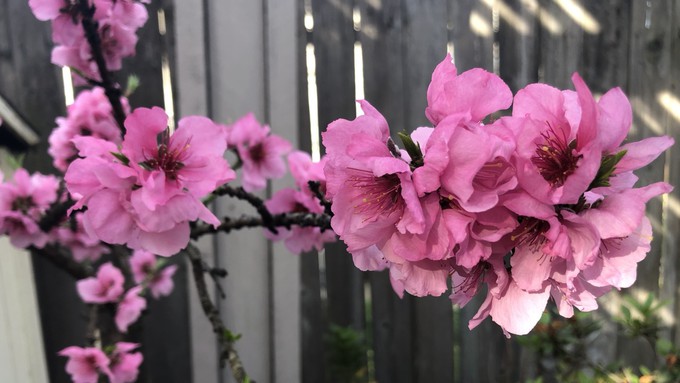
Overnight lows could reach 29 degrees, kill crops and damage plumbing

Wet today, frozen tomorrow? The predicted temperature drop could harm tender plants and blossoms on fruit trees. Kathy Morrison
Get ready for a big chill. Tuesday morning, the Sacramento office of the National Weather Service issued an “Urgent Weather Message” – freeze warnings for the next two nights.
With overnight lows expected to dip down to 29 to 32 degrees, back-to-back overnight freeze warnings will be in effect from 2 a.m. to 8 a.m. Wednesday and Thursday (March 1 and 2) for Southern Sacramento Valley-Carquinez Strait and Delta-Northern San Joaquin Valley, says the bulletin. That includes the cities of Sacramento, Fairfield, Suisun City, Stockton and Modesto.
Potential impacts could be costly, warns the weather service. “Frost and freeze conditions will kill crops, other sensitive vegetation and possibly damage unprotected outdoor plumbing.”
Those subfreezing temperatures will hit after the Sacramento skies clear and the rain stops late Tuesday, so there’s little chance of snow or graupel, says the forecast.
These two freezes to start March follow a rainy end to February. With rain on six consecutive days, Downtown Sacramento recorded more than 2 inches, including a record 0.91 inches Friday (Feb. 24). All this precipitation will keep soil moist, which is good frost protection. Moist soil retains heat better than dry soil. That difference can raise the temperature around trees and shrubs by three or four degrees – just enough to stay above freezing and frost damage.
That rain also means there’s no need for added irrigation; turn off the sprinklers and drip systems.
Making sure there’s no water in landscape pipes, tubes and heads can help prevent damage during freezing temperatures, too.
Between showers Tuesday, take action. Move plants or add frost covers. Harvest ripe citrus.
The weather service recommends these precautions: “Take steps now to protect tender plants from the cold. To prevent freezing and possible bursting of outdoor water pipes, they should be wrapped, drained, or allowed to drip slowly. Those that have in-ground sprinkler systems should drain them and cover above-ground pipes to protect them from freezing.”
For more tips on freezing and frost: https://ipm.ucanr.edu/PMG/GARDEN/ENVIRON/frostdamage.html.
Comments
0 comments have been posted.Sacramento Digs Gardening to your inbox.
Food in My Back Yard Series
May 6: Maintain soil moisture with mulch for garden success
April 29: What's (already) wrong with my tomato plants?
April 22: Should you stock up on fertilizer? (Yes!)
April 15: Grow culinary herbs in containers
April 8: When to plant summer vegetables
April 1: Don't be fooled by these garden myths
March 25: Fertilizer tips: How to 'feed' your vegetables for healthy growth
March 18: Time to give vegetable seedlings some more space
March 11: Ways to win the fight against weeds
March 4: Potatoes from the garden
Feb. 25: Plant a fruit tree now -- for later
Feb. 18: How to squeeze more food into less space
Feb. 11: When to plant? Consider staggering your transplants
Feb. 4: Starting in seed starting
Sites We Like
Garden Checklist for week of May 11
Make the most of the lower temperatures early in the week. We’ll be back in the 80s by Thursday.
* Plant, plant, plant! It’s prime planting season in the Sacramento area. Time to set out those tomato transplants along with peppers and eggplants. Pinch off any flowers on new transplants to make them concentrate on establishing roots instead of setting premature fruit.
* Direct-seed melons, cucumbers, summer squash, corn, radishes, pumpkins and annual herbs such as basil.
* Harvest cabbage, lettuce, peas and green onions.
* In the flower garden, direct-seed sunflowers, cosmos, salvia, zinnias, marigolds, celosia and asters. (You also can transplant seedlings for many of the same flowers.)
* Plant dahlia tubers.
* Transplant petunias, marigolds and perennial flowers such as astilbe, columbine, coneflowers, coreopsis, dahlias, rudbeckia and verbena.
* Keep an eye out for slugs, snails, earwigs and aphids that want to dine on tender new growth.
* Feed summer bloomers with a balanced fertilizer.
* For continued bloom, cut off spent flowers on roses as well as other flowering plants.
* Add mulch to the garden to maintain moisture. Mulch also cuts down on weeds. But don’t let it mound around the stems or trunks of trees or shrubs. Leave about a 6-inch-to-1-foot circle to avoid crown rot or other problems.
* Remember to weed! Pull those nasties before they set seed.
* Water early in the day and keep seedlings evenly moist.